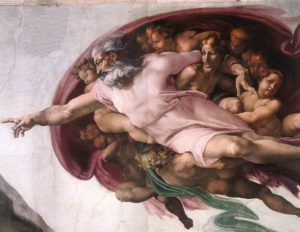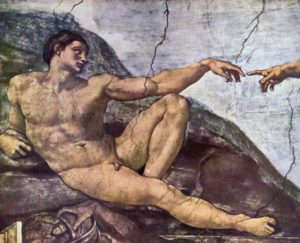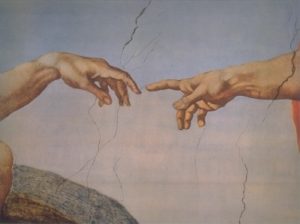The Creation of Adam is a fresco painting by Michelangelo. The painting forms a part of the Sistine Chapel’s ceiling and it was painted between 1508 and 1512. The Creation of Adam shows the Biblical creation narrative from the Book of Genesis in which God breathes life into Adam, the first man. Take a look below for 25 more interesting and bizarre facts about The Creation of Adam painting.
1. The painting is part of a complex iconographic scheme and it’s chronologically the fourth in the series of panels depicting episodes from Genesis.
2. The image of the near touching hands of God and Adam have becoming iconic of humanity.
3. The painting has been reproduced in countless imitations and parodies.
4. Leonardo da Vinci’s The Last Supper and Michelangelo’s The Creation of Adam are the most replicated religious paintings of all time.
5. Michelangelo was originally hired to paint the Twelve Apostles on the triangular pendentives that supported the ceiling, and cover the central part of the ceiling with ornament. However, Michelangelo persuaded Pope Julius to give him a free hand and proposed a different and more complex scheme, representing the Creation, the Fall of Man, the Promise of Salvation through the prophets and the genealogy of Christ.
6. The Creation of Adam is part of a much larger scheme of decoration and art within the chapel, which represents much of the doctrine of the Catholic Church.

7. The entire creation is over 500 square metres of ceiling, containing well over 300 figures.
8. At the center of the massive creation are the 9 episodes from the Book of Genesis, divided into three groups, God’s Creation of the Earth, God’s Creation of Humankind and their fall from God’s grace.
9. Apart from The Creation of Adam, other famous paintings on the ceiling are Adam and Eve in the Garden of Eden, the Deluge, the Prophet Jeremiah and the Cumaen Sibyl.
10. In the painting, God is depicted as an elderly white bearded man wrapped in a swirling cloak while Adam, who’s on the lower left, is completely nude. God’s right arm is outstretched to impark the spark of life from his own finger into Adam, whose left arm is extended in a pose mirroring God’s, a reminder that man was created in the image and likeness of God.
11. Adam’s finger and God’s finger never actually touch in the painting. It gives the impression that God, who is the giver of life, is reaching out to Adam who has yet to receive it.
12. Many people speculate on who the 12 figures around God are. Some people believe that the person protected by God’s left arm might be Eve due to the figure’s feminine appearance and the gaze towards Adam.
13. Generally, The Creation of Adam is thought to depict the excerpt from Genesis that stated, “God created man in His own image, in the image of God He created him.”
14. Michelangelo’s inspiration for Adam might have come from a cameo that showed a nude Augustus Caesar riding sidesaddle on a Capricorn. The cameo used to belong to cardinal Domenico Grimani who lived in Rome while Michelangelo painted the ceiling.
15. In 1990, an Anderson, Indiana physician, Frank Meshberger, noted in the Journal of the American Medical Association that the background figures and shapes portrayed behind the figure of God appeared to be an anatomically accurate picture of the human brain.

16. If you look closely at the painting, the borders correlate with major sulci of the cerebrum in the inner and outer surface of the brain, the brain stem, the frontal lobe, the basilar artery, the pituitary gland and the optic chiasm.
17. The red cloth around God has the shape of a human uterus, and the scarf hanging out could be a newly cut umbilical cord.
18. A group of Italian researchers published an article in the Mayo Clinic Proceedings, where the images of the mantle and the postpartum uterus were overlapped.
19. Michelangelo reluctantly accepted the commission to paint the ceiling of the Sistine Chapel, as he considered himself to be a sculptor and not a painter.
20. He struggled with the physical strain of the work and in 1509, he even wrote a poem about it, complaining to his friend Giovanni da Pistoia, “I’ve already grown a goitre from this tortue.”
21. It’s believed that Michelangelo painted the ceiling lying on his back, but he actually constructed his own system of scaffolding, so that he could paint standing up for more precision and control.
22. Michelangelo worked on the frescoes for 4 years and left God for last. He wanted to first refine his technique to depict Him perfectly.

23. He completed the entire ceiling without being able to see his work as a whole, since the scaffolding remained in place right until the very end. The first time he saw his creation was at its unveiling.
24. The many nudes in the frescoes have caused controversy in the past. In 1564, the Council of Trent deemed the paintings indecent and ordered Daniele da Volterra to cover them up with fig leaves, clothing and other items.
25. During major restorations done between the 1980s and 1990s, many of these additions were removed, revealing numerous, previously unseen details.




